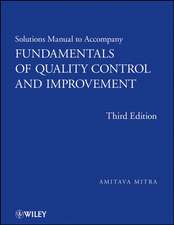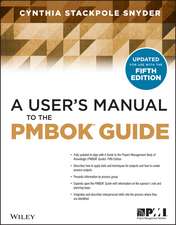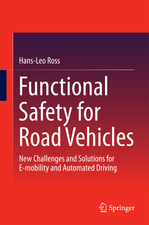Continuous Transcutaneous Monitoring: Advances in Behavioral Biology, cartea 7
Autor Albert Huch, Renate Huch, Gösta Roothen Limba Engleză Paperback – 4 noi 2011
Din seria Advances in Behavioral Biology
- 5%
 Preț: 368.00 lei
Preț: 368.00 lei -
 Preț: 401.79 lei
Preț: 401.79 lei -
 Preț: 406.63 lei
Preț: 406.63 lei - 15%
 Preț: 649.54 lei
Preț: 649.54 lei -
 Preț: 387.20 lei
Preț: 387.20 lei -
 Preț: 405.28 lei
Preț: 405.28 lei -
 Preț: 381.43 lei
Preț: 381.43 lei - 5%
 Preț: 378.07 lei
Preț: 378.07 lei - 5%
 Preț: 372.76 lei
Preț: 372.76 lei - 5%
 Preț: 724.50 lei
Preț: 724.50 lei - 5%
 Preț: 668.50 lei
Preț: 668.50 lei - 5%
 Preț: 378.97 lei
Preț: 378.97 lei - 15%
 Preț: 672.62 lei
Preț: 672.62 lei -
 Preț: 385.08 lei
Preț: 385.08 lei - 15%
 Preț: 673.27 lei
Preț: 673.27 lei -
 Preț: 407.39 lei
Preț: 407.39 lei - 5%
 Preț: 713.74 lei
Preț: 713.74 lei - 5%
 Preț: 716.84 lei
Preț: 716.84 lei - 5%
 Preț: 372.59 lei
Preț: 372.59 lei - 15%
 Preț: 680.47 lei
Preț: 680.47 lei - 15%
 Preț: 687.19 lei
Preț: 687.19 lei - 15%
 Preț: 596.01 lei
Preț: 596.01 lei -
 Preț: 421.05 lei
Preț: 421.05 lei - 15%
 Preț: 661.65 lei
Preț: 661.65 lei - 15%
 Preț: 663.27 lei
Preț: 663.27 lei - 5%
 Preț: 402.17 lei
Preț: 402.17 lei - 5%
 Preț: 369.29 lei
Preț: 369.29 lei -
 Preț: 409.30 lei
Preț: 409.30 lei - 15%
 Preț: 660.18 lei
Preț: 660.18 lei -
 Preț: 386.00 lei
Preț: 386.00 lei - 15%
 Preț: 646.62 lei
Preț: 646.62 lei -
 Preț: 403.15 lei
Preț: 403.15 lei -
 Preț: 397.59 lei
Preț: 397.59 lei -
 Preț: 406.63 lei
Preț: 406.63 lei - 5%
 Preț: 756.15 lei
Preț: 756.15 lei - 5%
 Preț: 406.57 lei
Preț: 406.57 lei - 15%
 Preț: 638.11 lei
Preț: 638.11 lei - 5%
 Preț: 389.93 lei
Preț: 389.93 lei - 5%
 Preț: 392.13 lei
Preț: 392.13 lei - 5%
 Preț: 719.74 lei
Preț: 719.74 lei -
 Preț: 389.49 lei
Preț: 389.49 lei - 5%
 Preț: 2147.36 lei
Preț: 2147.36 lei - 5%
 Preț: 1424.68 lei
Preț: 1424.68 lei - 5%
 Preț: 1430.35 lei
Preț: 1430.35 lei - 5%
 Preț: 2124.15 lei
Preț: 2124.15 lei
Preț: 395.85 lei
Nou
Puncte Express: 594
Preț estimativ în valută:
75.75€ • 79.35$ • 62.78£
75.75€ • 79.35$ • 62.78£
Carte tipărită la comandă
Livrare economică 09-23 aprilie
Preluare comenzi: 021 569.72.76
Specificații
ISBN-13: 9781461290711
ISBN-10: 1461290716
Pagini: 344
Ilustrații: XIII, 328 p.
Dimensiuni: 178 x 254 x 18 mm
Greutate: 0.6 kg
Ediția:Softcover reprint of the original 1st ed. 1987
Editura: Springer Us
Colecția Springer
Seria Advances in Behavioral Biology
Locul publicării:New York, NY, United States
ISBN-10: 1461290716
Pagini: 344
Ilustrații: XIII, 328 p.
Dimensiuni: 178 x 254 x 18 mm
Greutate: 0.6 kg
Ediția:Softcover reprint of the original 1st ed. 1987
Editura: Springer Us
Colecția Springer
Seria Advances in Behavioral Biology
Locul publicării:New York, NY, United States
Public țintă
ResearchCuprins
Reviews of Main Themes.- History, Status and Future of Pulse Oximetry.- Possibilities and Limitations of the Transcutaneous Measuring Technique. A Theoretical Analysis.- Growth and Development of Transcutaneous Monitoring in the U.S.A. — 1978-1986.- Transcutaneous Po2 and Pco2 Monitoring at 37°C. Cutaneous Po2 and Pco2.- Performance of Transcutaneous Electrodes.- The Measurement of tcPo2 and tcPco2 in Newborn Infants at 44°C, 42°C and 37°C after Initial Heating to 44°C.- Drift in Vivo of Transcutaneous Dual Electrodes.- Evaluation of Single Sensor Transcutaneous Measurement of Po2 and Pco2 in the Neonate.- Current Correction Factors Inadequately Predict the Relationship between Transcutaneous (tc) and Arterial Pco2 in Sick Neonates.- Computing the Oxygen Status of the Blood from Heated Skin Po2.- Application in Adults.- Transcutaneous Monitoring of Po2 and Pco2 during Running — A Non-Invasive Determination of Gas Transport.- Transcutaneous Oxygen Tension during Exercise in Patients with Pulmonary Emphysema.- The Effect of Inhaled Bronchoconstrictors on Transcutaneous Gas Tensions in Normal Adult Subjects.- In Vivo Calibration of a Transcutaneous Oxygen Electrode in Adult Patients.- Inflammation and Transcutaneous Measurement of Oxygen Pressure in Dermatology.- Diagnostic Assessment of Diabetic Microangiopathy by tcPo2 Stimulation Tests.- Application in Perinatology.- Transcutaneous Blood Gases and Sleep Apnea Profile in Healthy Preterm Infants during Early Infancy.- Transcutaneous Monitoring as Trigger for Therapy of Hypoxemia during Sleep.- Effectiveness of Combined Transcutaneous Po2/Pco2 Monitoring of Newborns.- Incidence and Severity of Retinopathy in Low Birth Weight Infants Monitored by tcPo2.- Transcutaneous Oxygen Monitoring and Retinopathy ofPrematurity.- Combined Transcutaneous Oxygen, Carbon Dioxide Tensions and End-expired CO2 Levels in Severely Ill Newborns.- Transcutaneous Po2 and Pco2 during Surfactant Therapy in Newborn Infants witn Idiopathic Respiratory Distress Syndrome.- Continuous Fetal Acid-Base Assessment during Labour by tcPco2 Monitoring.- Microvascular Dynamics during Acute Asphyxia in Chronically Prepared Fetal Sheep near Term.- Pulse Oximetry.- Pulse Oximetry: Physical Principles, Technical Realization and Present Limitations.- Pulse Oximetry - an Alternative to Transcutaneous Po2in Sick Newborns.- Application of the Ohmeda Biox 3700 Pulse Oximeter to Neonatal Oxygen Monitoring.- Pulse Oximetry and Transcutaneous Oxygen Tension for Detection of Hypoxemia in Critically Ill Infants and Children.- Is Pulse Oximetry Reliable in Detecting Hyperoxemia in the Neonate?.- Comparison between Transcutaneous Po2 and Pulse Oximetry for Monitoring O2-Treatment in Newborns.- The Accuracy of the Pulse Oximeter in Neonates.- Pulse Oximetry and Transcutaneous Oxygen Tension in Hypoxemic Neonates and Infants with Bronchopulmonary Dysplasia.- Control of Pedicle and Microvascular Tissue Transfer by Photometric Reflection Oximetry.- Comparison of in Vivo Response Times between Pulse Oximetry and Transcutaneous PO2 Monitoring.- Errors in the Measurement of CO-Hemoglobin in Fetal Blood by Automated Multicomponent Analysis.- A Simple Method for HbF Analysis.- Skin Blood Flow.- Capillary Blood Pressure.- Microvasculatory Evaluation of Vasospastic Syndromes.- Infrared Fluorescence Videomicroscopy with Indocyanine Green (Cardiogreen ®).- Measurement of Tissue Blood Flow by High Frequency Doppler Ultrasound.- Laser-Doppler Probes for the Evaluation of Arterial Ischemia.- Skin Reactive Hyperemia Recorded by aCombined tcPo2 and Laser Doppler Sensor.- Comparison of Laser-Doppler-Flux and tcPo2 in Healthy Probands and Patients with Arterial Ischemia.- The Use of the Hellige Oxymonitor to Study Skin Blood Flow Changes.- Calculation of Skin Blood Flow.- Estimated Peripheral Blood FLow in Premature Newborn Infants.- Skin Blood Flow Calculations from Transcutaneous Gas Pressure Measurements.- The Percentual Initial Slope Index of tcPo2 as a Measure of the Peripheral Circulation and its Measurements by different tcPo2 Electrodes.- Examinations on the Blood Flow Dependence of tcPO2 Using the Model of the “Circulatory Hyperbola”.- Estimation of the Determinants of Transcutaneous Oxygen Tension Using a Dynamic Computer Model.- Technical Aspects of Continuous Monitoring.- Quality and Safety Aspects in the Development and Fabrication of Transcutaneous Sensors.- A New System for tcPo2 Long-Term Monitoring Using a Two-Electrode Sensor with Alternating Heating.- A Novel Approach for an ECG Electrode Integrated into a Transcutaneous Sensor.- Microelectronic Sensors for Simultaneous Measurement of Po2and pH.- A Modified Electrode Ring for Use in Transcutaneous Measurement of Po2.- Multichannel Recording and Analysis of Physiological Data Using a Personal Computer.- Continuous Non-Invasive Beat-by-Beat Blood Pressure (B.P.) Measurement in the Newborn.- The Relative Accuracy of Three Transcutaneous Dual Electrodes at 45° in Adults.- Contributors.











